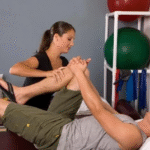
Pediatric Nutrition and Growth Monitoring Guidelines
September 26, 2025
Physical Therapy Exercises for Knee Injury Recovery
September 26, 2025
A stroke can be a life-changing event, leaving patients with challenges that affect movement, balance, speech, and daily activities. Recovery after a stroke is a gradual process, and physical therapy plays a vital role in helping patients regain independence, strength, and confidence. This article explores the importance of physical therapy for stroke patients, different treatment approaches, and tips for effective rehabilitation.
Understanding Stroke and Its Impact
A stroke occurs when the blood flow to a part of the brain is interrupted or reduced, depriving brain tissue of oxygen and nutrients. There are two main types of strokes:
- Ischemic stroke – caused by a blood clot blocking a vessel in the brain.
- Hemorrhagic stroke – caused by bleeding in or around the brain.
Stroke can lead to long-term impairments such as:
- Weakness or paralysis on one side of the body
- Loss of coordination and balance
- Difficulty walking or performing daily tasks
- Muscle stiffness (spasticity)
- Fatigue
Physical therapy is crucial to help stroke patients recover these functions and improve their quality of life.
Goals of Physical Therapy for Stroke Patients
Physical therapy after a stroke focuses on restoring movement, preventing complications, and encouraging independence. The main goals include:
- Improving strength – Weak muscles often result from disuse after a stroke. Therapy strengthens these muscles to regain functional movement.
- Enhancing balance and coordination – Stroke can disrupt coordination, making everyday tasks difficult. Therapists use exercises to improve stability.
- Reducing muscle stiffness – Spasticity is common after a stroke. Stretching and controlled movements help relax muscles.
- Increasing mobility – Therapists work on walking, standing, and transitioning between positions safely.
- Promoting independence – Ultimately, therapy helps patients return to daily life activities like dressing, eating, and personal care.
Types of Physical Therapy Treatments for Stroke Patients
Physical therapy treatments for stroke patients are tailored to individual needs. Here are some common approaches:
1. Range of Motion Exercises
After a stroke, muscles and joints can become stiff. Range of motion exercises involve gently moving joints to maintain flexibility and prevent contractures (permanent tightening of muscles). These exercises are usually passive at first, meaning the therapist moves the patient’s limbs, and gradually become active as strength improves.
2. Strengthening Exercises
Muscle weakness is common after a stroke. Therapists guide patients through exercises like:
- Leg lifts
- Arm raises
- Resistance band exercises
- Weight training (light weights)
These exercises gradually rebuild muscle strength, helping patients regain functional abilities like standing, walking, or lifting objects.
3. Balance and Coordination Training
Balance and coordination are often affected by stroke. Therapy includes:
- Standing on one leg
- Heel-to-toe walking
- Sitting-to-standing practice
- Using stability balls or balance boards
These exercises improve posture, stability, and prevent falls.
4. Gait Training
Walking may become difficult after a stroke. Gait training focuses on improving walking patterns through:
- Assisted walking with a therapist
- Using parallel bars for support
- Treadmill training with body weight support
- Foot placement and step symmetry exercises
Gait training restores confidence and mobility in everyday life.
5. Functional Task Practice
Physical therapists help stroke patients perform everyday activities, also known as activities of daily living (ADLs). This includes:
- Dressing and undressing
- Getting in and out of bed
- Using utensils for eating
- Reaching and grasping objects
Practicing these tasks in therapy translates to independence at home.
6. Constraint-Induced Movement Therapy (CIMT)
For patients with limited use of one arm or hand, CIMT encourages the use of the affected limb. The stronger limb is temporarily restrained, forcing the patient to practice functional tasks with the weaker side. This promotes neuroplasticity—the brain’s ability to rewire and form new connections.
7. Hydrotherapy
Water-based exercises can be very beneficial. The buoyancy of water reduces the strain on joints and supports the body, making movement easier. Hydrotherapy improves strength, balance, and flexibility in a low-impact environment.
8. Electrical Stimulation
In some cases, therapists use electrical stimulation on muscles to improve contraction and prevent atrophy. This technique helps retrain muscles and improve functional movement.
Importance of Early and Consistent Therapy
Starting physical therapy as soon as medically safe after a stroke can significantly improve outcomes. Early therapy:
- Prevents complications such as muscle stiffness, joint contractures, and deep vein thrombosis
- Encourages quicker recovery of strength and mobility
- Improves overall independence and quality of life
Consistency is key. Daily exercises, even if short, are more effective than occasional long sessions. A structured home exercise program complements therapy sessions and accelerates recovery.
Role of Family and Caregivers
Family members and caregivers play a crucial role in supporting stroke patients during physical therapy. They can:
- Encourage regular practice of exercises at home
- Assist with safe mobility and transfers
- Celebrate small achievements to boost motivation
- Communicate progress and challenges to the therapist
A supportive environment enhances recovery and emotional well-being.
Tips for Stroke Patients During Physical Therapy
- Set realistic goals – Recovery takes time; celebrate small milestones.
- Stay patient – Progress may be slow initially, but consistent effort pays off.
- Maintain proper nutrition – A balanced diet supports muscle recovery and energy levels.
- Monitor for pain or discomfort – Inform your therapist if exercises cause pain.
- Stay hydrated – Proper hydration aids muscle function and overall health.
Conclusion
Physical therapy treatments for stroke patients are essential for regaining independence, strength, and mobility. With tailored exercises, consistent practice, and support from therapists and caregivers, stroke survivors can improve their quality of life and return to meaningful activities. Every patient’s journey is unique, and recovery may take time, but with perseverance and professional guidance, significant progress is achievable.
FAQs About Physical Therapy for Stroke Patients
1. How long does physical therapy for stroke recovery last?
The duration varies depending on the severity of the stroke. Some patients may require months of therapy, while others may continue for a year or longer. Consistency and early intervention often lead to better outcomes.
2. Can physical therapy restore full mobility after a stroke?
While full recovery is not guaranteed for every patient, physical therapy can significantly improve mobility, strength, and independence. Many patients regain the ability to perform daily activities with confidence.
3. Is physical therapy painful for stroke patients?
Therapy may cause mild discomfort, especially when muscles are weak or stiff. However, exercises are designed to be safe and gradually increase in intensity. Therapists adjust activities to minimize pain while promoting recovery.
4. Can stroke patients do exercises at home?
Yes. Therapists usually provide a home exercise program to reinforce what is learned during therapy sessions. Following these exercises consistently helps speed up recovery.
5. When should a stroke patient start physical therapy?
Therapy should begin as soon as the patient is medically stable. Early intervention prevents complications and encourages quicker recovery of movement and function.

